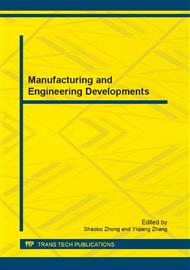[1]
Wang Limei, Zuo Tao, Wu Zhitao. PMLSM controller design based on self-constructing feedback fuzzy neural network, 2009 Chinese Control and Decision Conference(CCDC 2009): pp.3146-3150.
DOI: 10.1109/ccdc.2009.5192880
Google Scholar
[2]
ZHANG Ying, CHEN You-ping, AI Wu, ZHOU Zu-de, Design strategy for detent force reduction of permanent magnet linear synchronous, Journal of Shanghai University(Engl Ed, 2008, 12(6), pp.548-553.
DOI: 10.1007/s11741-008-0615-2
Google Scholar
[3]
GUAN Lirong, GONG Min, SUN Shengbing. Adaptive backstepping sliding mode robust tracking control for permanent magnet linear synchronous motor. Electric Drive, 2009(6): pp.58-61.
DOI: 10.1109/iccee.2008.170
Google Scholar
[4]
WANG Li-mei, WU Zhi-tao, ZUO Tao. PMLSM self-construction fuzzy neural network controller design. Electric machines and Control, 2009, 9(5). pp.643-647.
DOI: 10.1109/ccdc.2009.5192880
Google Scholar
[5]
WANG WU. Adaptive neuro sliding mode control for inverted pendulum. 2010 2nd Internation Conference on Computer Engineering and Technology (ICCET2010) , 2010, VOL 1, pp.135-138.
DOI: 10.1109/iccet.2010.5486253
Google Scholar
[6]
Zhao Xia, Jiang Yuxian, Wu Yunjie, Zhou Yingqiang. Fast nonsingular terminal sliding mode control based on multi-slide-mode, Journal of Beijing University of Aeronautics and Astronautics, 2011, 1: pp.110-113.
DOI: 10.1109/icicisys.2009.5358358
Google Scholar
[7]
Lei Yuan and Han-song Wu. Terminal Sliding Mode Fuzzy Control Based on Multiple Sliding Surface for Nonlinear Ship Autopilot Systems. Journal of Marine Science and Application, 2010, (9). pp.425-430.
DOI: 10.1007/s11804-010-1029-y
Google Scholar
[8]
ZHAO De-zong, ZHANG Cheng-jin, HAO Lan-ying. A Robust Sliding-mode Control Strategy of a Speed Sensorless Induction Machine, Proceeding of the CSEE, 2006, 11, pp.122-127.
Google Scholar
[9]
Wang Wu, Su Liang-yu. Application of CMAC-PID Compound Control in PMLSM Servo System[J]. Advanced Materials Research Vols. 341-342(2012), pp.780-784.
DOI: 10.4028/www.scientific.net/amr.341-342.780
Google Scholar
[10]
Wang Wu, Wang Hong-ling, Bai Zheng-min. Fault Diagnosis of Three Level Inverter Based on Improved Neural Networks[J]. Lecture Notes in Electrical Engineering, 2011, Vol. 97, pp.55-62.
DOI: 10.1007/978-3-642-21697-8_8
Google Scholar


